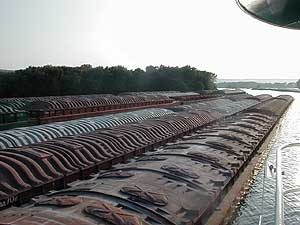|
Audio
Photos
Resources
Your Voice
|
Army Corps presents navigation options to states
February 24, 2004
The Army Corps of Engineers will present its preferences for how to manage the Upper Mississippi River for the next 50 years. It's the culmination of 10 years of study and $60 million in planning and research. The Army Corps' navigation study has long been a source of controversy amidst allegations of skewed numbers and bias. Critics say they're gearing up for another long fight.
Rochester, Minn. — The Army Corps of Engineers has a broad range of proposals for improving commercial navigation on the upper Mississippi River. It has been whittling down the list and will now present the proposal it supports. The plan calls for among other things the construction of 12 new locks. At a price of $2.3 billion, it's the most extensive and the most costly of all the proposals the agency considered.
 | |||
The Corps' Ron Fournier says it's the best plan for the U.S. economy. The river is considered an important transportation corridor. And Fournier says it needs to be improved if the country is to maintain its position in the global marketplace.
The plan has the backing of the barge industry.
Fournier says the clock is ticking.
"We can't wait. Congress wants this report this year. We have to give them this report," he explains. "We have to give them the results of this study that's been going on for ten years and tell them that what we have right now with the modeling and the best science we have today this is what we see."
Fournier says the plan could be implemented in phases, allowing the Corps to make improvements gradually over five decades. That would provide the opportunity to reassess each project before beginning construction.
Fournier cautions while the Corps may be leaning towards what's known as Alternative 6 nothing will be official until spring.
But environmental groups who have long been critical of the Army Corps worry the decision has been made. They're getting ready for a fight.
Scott Faber's a water resource specialist with Environmental Defense, a group based in Washington DC. He says there's no science or sound economic reason behind the Army Corps position.
"The evidence for restoring the Mississippi River couldn't be greater. The evidence for building new locks and dams couldn't be weaker," says Faber. "There hasn't been an increase in traffic on the Mississippi River in two decades. In fact traffic has fallen in some locks since the study began a decade ago by 20 percent."
Faber says his organization is lobbying Congress to implement smaller scale changes to ease barge congestion during the busy summer months. They've suggested things like scheduling lock time in advance to prevent time-consuming bottlenecks. The National Academy of Sciences suggested similar approaches in two reports critical of the Corps plan. The Academy also raised concerns about the accuracy and effectiveness of the Corps economic models.
Alongside, a plan for improvements to the lock and dam system, the Corps will also propose funding for improving the rivers environment. The Corps prefers a plan, which will spend more than $5 billion over 50 years on ecosystem restoration. While environmental groups are anxious for the funding, they are concerned it will be an easy target in times of budget cuts.
Dan McGuinness of the Audubon society says current programs for restoring the Mississippi River have never been fully funded. He says it's likely that trend will continue.
"We think it would be easy for Congress with a stroke of a pen to authorize $100 million a year and then turn around it and fund it at $20 million a year while they're building new locks and dams," says McGuinness. "We're quite concerned about that."
McGuinness is pushing for a proportional funding clause in the plan. He says it would ensure a constant ratio for funding for navigation and environmental projects.
McGuinness plans to attend the meeting in St. Louis, along with state and federal officials. However, McGuinness and other environmentalists will only be allowed to observe. They cannot participate in the discussions.
The Army Corps plans to use the session to gather input, but ultimately it will decide which proposal for navigation and environmental restoration it will send on to Congress.
|
News Headlines
|
Related Subjects
|

